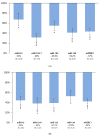The Chemopreventive Effects of Polyphenols and Coffee, Based upon a DMBA Mouse Model with microRNA and mTOR Gene Expression Biomarkers
- PMID: 35455979
- PMCID: PMC9029301
- DOI: 10.3390/cells11081300
The Chemopreventive Effects of Polyphenols and Coffee, Based upon a DMBA Mouse Model with microRNA and mTOR Gene Expression Biomarkers
Abstract
Polyphenols are capable of decreasing cancer risk. We examined the chemopreventive effects of a green tea (Camellia sinensis) extract, polyphenol extract (a mixture of blackberry (Rubus fruticosus), blackcurrants (Ribes nigrum), and added resveratrol phytoalexin), Chinese bayberry (Myrica rubra) extract, and a coffee (Coffea arabica) extract on 7,12-dimethylbenz[a]anthracene (DMBA) carcinogen-increased miR-134, miR-132, miR-124-1, miR-9-3, and mTOR gene expressions in the liver, spleen, and kidneys of CBA/Ca mice. The elevation was quenched significantly in the organs, except for miR-132 in the liver of the Chinese bayberry extract-consuming group, and miR-132 in the kidneys of the polyphenol-fed group. In the coffee extract-consuming group, only miR-9-3 and mTOR decreased significantly in the liver; also, miR-134 decreased significantly in the spleen, and, additionally, miR-124-1 decreased significantly in the kidney. Our results are supported by literature data, particularly the DMBA generated ROS-induced inflammatory and proliferative signal transducers, such as TNF, IL1, IL6, and NF-κB; as well as oncogenes, namely RAS and MYC. The examined chemopreventive agents, besides the obvious antioxidant and anti-inflammatory effects, mainly blocked the mentioned DMBA-activated factors and the mitogen-activated protein kinase (MAPK) as well, and, at the same time, induced PTEN as well as SIRT tumor suppressor genes.
Keywords: 7,12-dimethylbenz[a]anthracene; carcinogen; coffee; mTOR; miR; miR-124-1; miR-132; miR-134; miR-9-3; polyphenol.
Conflict of interest statement
The note that they have no conflict of interest.
Figures









Similar articles
-
The effects of flavonoids, green tea polyphenols and coffee on DMBA induced LINE-1 DNA hypomethylation.PLoS One. 2021 Apr 20;16(4):e0250157. doi: 10.1371/journal.pone.0250157. eCollection 2021. PLoS One. 2021. PMID: 33878138 Free PMC article.
-
Changes in miR-124-1, miR-212, miR-132, miR-134, and miR-155 Expression Patterns after 7,12-Dimethylbenz(a)anthracene Treatment in CBA/Ca Mice.Cells. 2022 Mar 17;11(6):1020. doi: 10.3390/cells11061020. Cells. 2022. PMID: 35326471 Free PMC article.
-
Effect of E-2-(4'-methoxybenzylidene)-1-benzosuberone on the 7,12-dimethylbenz[alpha]anthracene-induced onco/suppressor gene action in vivo. I: A 24-hour experiment.Anticancer Res. 2000 Jan-Feb;20(1A):475-81. Anticancer Res. 2000. PMID: 10769699
-
Cafestol and kahweol, two coffee specific diterpenes with anticarcinogenic activity.Food Chem Toxicol. 2002 Aug;40(8):1155-63. doi: 10.1016/s0278-6915(02)00029-7. Food Chem Toxicol. 2002. PMID: 12067578 Review.
-
Green tea and skin--anticarcinogenic effects.J Invest Dermatol. 1994 Jan;102(1):3-7. doi: 10.1111/1523-1747.ep12371720. J Invest Dermatol. 1994. PMID: 8288907 Review.
Cited by
-
Environmental and Lifestyle Cancer Risk Factors: Shaping Extracellular Vesicle OncomiRs and Paving the Path to Cancer Development.Cancers (Basel). 2023 Aug 29;15(17):4317. doi: 10.3390/cancers15174317. Cancers (Basel). 2023. PMID: 37686592 Free PMC article.
-
Nutraceutical Properties of Syringic Acid in Civilization Diseases-Review.Nutrients. 2023 Dec 19;16(1):10. doi: 10.3390/nu16010010. Nutrients. 2023. PMID: 38201840 Free PMC article. Review.
-
Annona Muricata L. extract restores renal function, oxidative stress, immunohistochemical structure, and gene expression of TNF-α, IL-β1, and CYP2E1 in the kidney of DMBA-intoxicated rats.Front Pharmacol. 2024 Feb 1;15:1348145. doi: 10.3389/fphar.2024.1348145. eCollection 2024. Front Pharmacol. 2024. PMID: 38362149 Free PMC article.
-
Liver Cancer Etiology: Old Issues and New Perspectives.Curr Oncol Rep. 2024 Nov;26(11):1452-1468. doi: 10.1007/s11912-024-01605-7. Epub 2024 Oct 10. Curr Oncol Rep. 2024. PMID: 39388026 Review.
-
Fruit Extract, Rich in Polyphenols and Flavonoids, Modifies the Expression of DNMT and HDAC Genes Involved in Epigenetic Processes.Nutrients. 2023 Apr 13;15(8):1867. doi: 10.3390/nu15081867. Nutrients. 2023. PMID: 37111085 Free PMC article.
References
-
- Danaei G., Vander Hoorn S., Lopez A.D., Murray C.J., Ezzati M., Comparative Risk Assessment Collaborating Group (Cancers) Causes of cancer in the world: Comparative risk assessment of nine behavioural and environmental risk factors. Lancet. 2005;366:1784–1793. doi: 10.1016/S0140-6736(05)67725-2. - DOI - PubMed
-
- Bray F., Ferlay J., Soerjomataram I., Siegel R.L., Torre L.A., Jemal A. Global cancer statistics 2018: GLOBOCAN estimates of incidence and mortality worldwide for 36 cancers in 185 countries. CA Cancer J. Clin. 2018;68:394–424. doi: 10.3322/caac.21492. Erratum in CA Cancer J. Clin. 2020, 70, 313. - DOI - PubMed
MeSH terms
Substances
LinkOut - more resources
Full Text Sources
Research Materials
Miscellaneous

